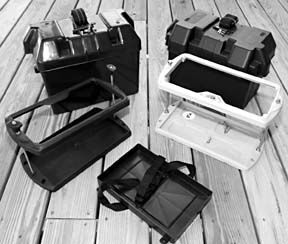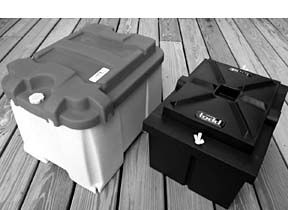Batteries boxes are often overlooked, yet are an essential and integral part of a vessel’s electrical system. A wet-cell battery not held firmly in place cannot perform its intended function, does not comply with Coast Guard regulations, and in rough seas can be dangerous. One option for securing the big, heavy batteries commonly found in larger auxiliary sailboats (like 4D, 8D, and GC2 golf cart batteries) is a plastic battery box. We look at two. Smaller boats, carrying size 24 to 31 batteries, often don’t have the room for big battery boxes. For that crowd we examined two smaller battery boxes and three tray-style hold-downs.

The first big box purchased was a model 4021, built by Blue Seas Systems. This unit holds two golf cart batteries. Two other models are also available; the 4022, built to hold a single 4D, and the 4023, sized for one 8D battery.
Our second big box came from Todd Enterprises. Five models are produced by Todd. We selected the Double Battery Box, designed to hold a pair of group 24 batteries. Other models are the 4D, 8D Low, 8D High, and 8D High Double.
The three tray-type hold-downs we tested were from Gil Marine, T & H Marine, and West Marine. The small battery boxes came from Tempo and West Marine.
Large Battery Boxes
When properly mounted, the big boxes from Todd and Blue Seas (see photo) should have no trouble meeting CG regulations for security. This means they’re capable of a sustained pull on the battery in five different directions with a force of 90 pounds. Both also have vented and secured lids. However, there are differences in design and construction. The Blue Seas 4021 has a double wall molded into the top 2-1/2″ of the box, helping to secure the batteries firmly in place and increase strength. The bottom is molded to hold the batteries above the actual bottom of the box, which leaves space to hold spilled electrolyte in the event of a leak. Hold-downs are molded into each outside corner and sized for 1/4″ fasteners. The plastic cover is attached with a pair of bolts, one on each end, with large plastic knobs for easy hand tightening. Threaded bronze fittings pressed into the top of the box receive the bolts. They remain with the cover even when it is off the box, held in place by nylon washers.
Eight outlets molded into the box rim allow for battery cables to exit, each sized for a single cable. The cover has four matching outlets at one end; it can be flipped in either direction to accommodate a maximum of four cables from the box. We like the protective features found on the Blue Seas 4021, and it appears to be well constructed. We found the Blue Seas boxes priced between $59 to $64, depending on model.

The Todd Enterprises Double Battery Box is of single-wall construction and designed to have the batteries sit flat on the bottom. No hold-downs are provided; holes need to be drilled through the bottom of the box so that it can be fastened to the boat’s structure with fender washers inside the box and bolts or lags into the deck.
A shoebox joint on the cover keeps it from sliding, and two nylon bolts and wingnuts are provided to secure it in place. The nylon bolts were difficult to get through the holes and fit poorly. Two 1-3/4″ holes cut into the lid provide for cable exit. The Todd Double to single-8D boxes range in price from $40 to $64.
The Todd box is not as well designed or constructed as the Blue Seas 4021, in our view, but it will get the job done for less money.
Small Battery Boxes
The two small boxes we looked at from West Marine and Tempo Products (see photo above) are nearly identical in shape and construction—single-wall molded plastic with shoebox lids. Each is packaged with the same plastic strap, a pair of plastic strap hold-downs, and four small screws. The strap clamps are meant to be screwed to the deck at the front and back of the box, and the strap then encircles the box and is tightened. While we’ve used this type of box and strap on boats for many years, it’s not, in our opinion, very secure, especially with the small screws provided.
In some cases we’ve used the same method recommended by Todd, securing the box to the boat with four large fender washer-equipped screws shot through the bottom of the box. This has worked well to keep the boxes secure, but the issue is not the security of the box itself, but rather the security of the battery inside—there’s usually some play between the case side and the battery. This allows for some slight movement while underway—definitely not desirable. Another problem has been the strap. We’ve had more than one of the plastic strap latches break.
The final drawback on these boxes is the high sides. They require lifting very heavy batteries, in awkward positions, higher than if a battery tray were installed. They’re not recommended where space overhead is tight. Both boxes sell for $10.
Battery Trays
Two of the battery trays we examined are nearly identical—the West and the Gil. Both are composite plastic trays designed in two parts. A tray on the bottom holds the battery and is secured to the boat with four large screws. Each end of the bottom tray accepts a stainless steel rod that supports and secures the upper frame, which fits around the top perimeter of the battery. This effectively clamps the battery in place with no movement possible. It’s a good arrangement.
Another advantage of the tray is that you’ll only need to lift the battery about an inch off the deck to place it properly on the bottom tray, or to take it out for charging or replacement. That’s a true muscle-saving feature.
The Gil Marine tray came packaged with all the needed hardware, including screws to secure it. The Superstock version size 27, the one we tested, sells for $20. It’s also available in size 24 and is the middle level of three similar styles available from Gil.
West Marine’s battery tray is built by Attwood and is also available for size 24 and 27 batteries; it sells for $12 in size 27.
Because the tray-type hold-downs don’t have full lids, they require the addition of insulating terminal caps. These can be found at marine supply stores for just a few dollars. These terminal caps can be held securely in place with tie-wraps.
Our third tray-style battery box is from T & H Marine. It’s a one-piece molded plastic tray supplied with a strap, selling for $10. The tray is fastened down with four screws placed through tabs molded into the sides of the tray. The strap should be fitted under the tray prior to fastening to the deck. Then it goes over the battery and gets latched. This is not, in our view, as secure a hold-down method as on the Gil and West trays.
We prefer the battery trays available from West and Gil over the strap- equipped T & H tray or either of the boxes. Though they cost a couple of dollars more, and require terminal insulators, they should hold a battery more securely. They also don’t require lifting the battery high during installation or a change, and they take up less room inside the boat.
Contacts
• Blue Seas Systems, 800/222-7617, www.bluesea.com
• Gil Marine, 440/891-0999, www.gilmarine.com
• T & H Marine, 256/772-0164
• Tempo Products, 800/321-6301, www.tempoproducts.com
• Todd Enterprises, 401/467-2750, www.toddusa.com
• West Marine, 800/BOATING, www.westmarine.com






































